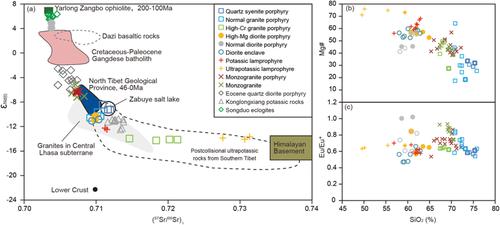当前位置:
X-MOL 学术
›
Geolog. J.
›
论文详情
Our official English website, www.x-mol.net, welcomes your feedback! (Note: you will need to create a separate account there.)
Miocene multi‐source magma system and magma mixing in the Zhunuo porphyry Cu deposit, southern Tibet, China
Geological Journal ( IF 1.8 ) Pub Date : 2020-08-02 , DOI: 10.1002/gj.3924 Aorigele Zhou 1, 2 , Qiu‐Ping Liu 1 , Ju‐Xing Tang 1 , Ming Xu 3 , Yi‐Yun Wang 4 , Ji‐Lin Duan 5 , Ming Zheng 1
Geological Journal ( IF 1.8 ) Pub Date : 2020-08-02 , DOI: 10.1002/gj.3924 Aorigele Zhou 1, 2 , Qiu‐Ping Liu 1 , Ju‐Xing Tang 1 , Ming Xu 3 , Yi‐Yun Wang 4 , Ji‐Lin Duan 5 , Ming Zheng 1
Affiliation

|
Zhuno is the only large porphyry copper deposit that preserves the complete magmatic system in the western part of Gangdese porphyry copper belt. Intrusions in the Zhunuo deposit include pre‐ore porphyritic monzogranite, syn‐ore monzogranite porphyry, and post‐ore quartz syenite‐normal granite porphyry, high‐Cr granite porphyry, normal diorite porphyry, high‐Mg diorite porphyry (diorite enclave), potassic lamprophyre, and ultrapotassic lamprophyre. Enriched Sr–Nd isotopic composition and high MgO, LILE, HFSE, LREE, and compatible element (Cr, Ni) contents of the ultrapotassic lamprophyre indicate that the magma derived from the enriched Lhasa lithospheric mantle, which had been metasomatized by fluids and sediment‐derived melts associated with Neo‐Tethyan oceanic subduction and subsequent Indian continental lithosphere subduction. The depletion of the Sr–Nd isotopic composition and MgO (or Mg#), Cr, and Ni content of the normal diorite porphyry manifest that the magma source is juvenile Lhasa lower crust instead of Indian mantle. Geochemical characteristics indicate that the magma sources of the quartz syenite‐normal granite porphyry, high‐Mg diorite porphyry‐diorite enclave, and potassic lamprophyre was derived from ancient Lhasa middle‐upper crust, crust‐mantle transition zone, and enriched Lhasa mantle without Indian lithosphere contribution, respectively. Their similar Sr–Nd isotopic compositions demonstrate a uniform Sr–Nd isotopic reservoir from crust to mantle in Zhunuo area. The major and trace element compositions suggest that the high‐Cr granite porphyry was formed by mixing of quartz syenite‐normal granite porphyry and ultrapotassic lamprophyre magmas. High Sr/Y values and low Y contents of the monzogranite and monzogranite porphyry display adakitic properties. The major and trace element contents and Sr–Nd isotopic composition indicate the monzogranite‐monzogranite porphyry are likely from mixing of the normal diorite porphyry magma with the quartz syenite‐normal granite porphyry magma, rather than with the high‐Mg dioritic (high‐Mg diorite porphyry‐diorite enclave) and/or potassic‐ultrapotassic magmas. According to the spatial and temporal consistency of the adakitic and potassic‐ultrapotassic rocks with the N–S‐trending rifts, Indo‐Asian convergence rate reduction, and uplifting model of Tibetan Plateau, we infer that the magma genesis of the Zhuno intrusions is attributed to decompressional partial melting of Lhasa crust‐mantle triggered by the tearing of the subducting Indian Plate.
更新日期:2020-08-02



























 京公网安备 11010802027423号
京公网安备 11010802027423号